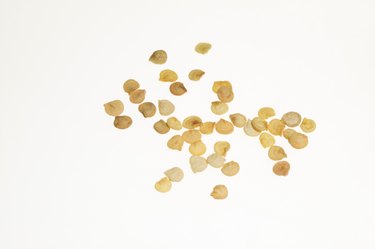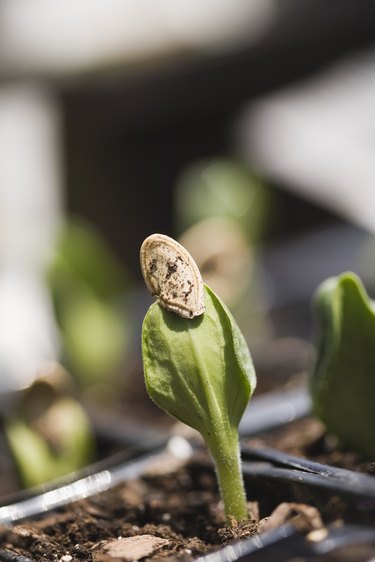
Starting plants from seed, while economical, can feel like spinning a roulette wheel. Some seeds germinate, some don't. Because of this, home gardeners are always on the lookout for ways to increase germination rates. At-home methods include stratification (chilling the seeds), mechanical scarification (nicking the seed coat with a pin or sharp knife) and chemical scarification, which involves soaking, rinsing or misting the seeds in water or a water and hydrogen peroxide solution.
Seeds Need to Breathe
Video of the Day
A seed needs light, water and oxygen to germinate. Most gardeners remember the light and water part of the germination equation, but overlook the seed's need for oxygen. Old seeds and seeds with particularly hard coats are particularly likely to come up short on the ability to absorb oxygen. This negatively impacts their germination rate -- and your garden success.
Video of the Day
Break Down Those Barriers

Recent scientific studies back up the effectiveness of chemically scarifying seeds by soaking them in a solution of hydrogen peroxide and water. Hydrogen peroxide is thought to increase germination rates by breaking down the seed coat, thus allowing the seed to take in more oxygen. In a study reported in the journal "HortScience," aged corn seeds (Zea mays L.) treated with a solution of 15 percent hydrogen peroxide germinated at a significantly greater percentage (nearly 95 percent) than seeds treated with aerated water but no hydrogen peroxide (67 percent germination rate). In addition, oxygen consumption rates of seeds soaked for 24 hours in the hydrogen peroxide solution were approximately twice as high as seeds soaked in aerated water for the same time.
Better Chance of Sprouting
A similar study, this one using seeds of eastern gamagrass (Tripsacum dactyloides), compared the effectiveness of stratification and hydrogen peroxide soaks. As reported in "Acta Horticulturae," the publication of the International Society for Horticultural Science, soaking seeds in a 15 percent hydrogen peroxide solution was most effective at breaking seed dormancy and inducing germination. Gamagrass is hardy growing in U.S. Department of Agriculture plant hardiness zones 8 through 11.
Help Your Seeds Breathe
It's easy to improve your at-home germination rates by using hydrogen peroxide in your pre-planting routine. Simply add 1 ounce of 3-percent hydrogen peroxide to 1 pint of water; choose one of the following three methods. One, soak your seeds for 18 to 24 hours, rinse and plant. Two, place your seeds on a length of paper towels, use a mister filled with the hydrogen peroxide-water solution to thoroughly dampen (but not soak) the towels and the seeds, then roll up the towels loosely or simply fold them over so that all sides of the seeds are in contact with moist paper towel. Mist them lightly each day (or when the towel dries out) and plant them when sprouts emerge. Three, just rinse your seeds with the solution, then plant.